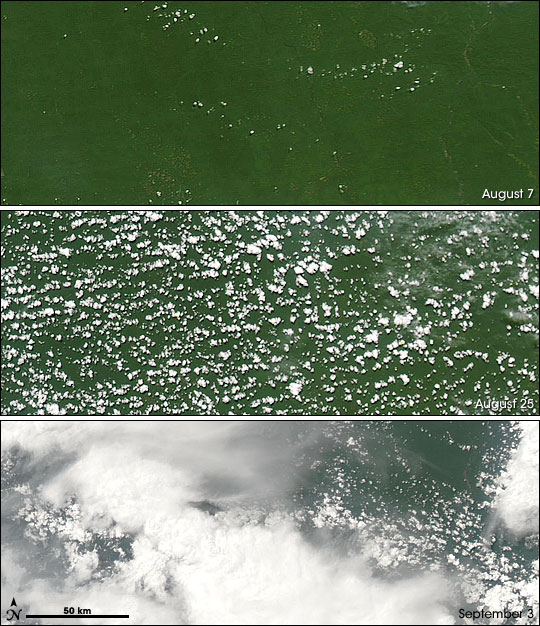


Despite its name, much of the Amazon Rainforest is not actually rainy year round. Many areas experience a monsoon climate, with a season of heavy rains followed by a dry season that can last anywhere from one to seven months. North of the equator, the rainy season occurs from June-August. South of the equator, it runs from October or November through March, April, or May. The processes that initiate the switch in where the rain falls are something of a mystery. In 2007, scientists discovered evidence that the forest itself triggers the switch. Increasing leaf area throughout the dry season may set off a chain of events that leads to a reversal in the north-south winds that carry moisture into one hemisphere or another.
This trio of photo-like images illustrates steps in the initiation of the wet season in the southern Amazon in 2006. Captured by the Moderate Resolution Imaging Spectroradiometer (MODIS) on NASA’s Aqua satellite, they show a progression from mostly clear skies on August 7, to popcorn-like, scattered cumulus clouds on August 25, to more widespread thunderstorm activity on September 3.
During the less-cloudy dry season, the team of scientists discovered, the ratio of leaf area to ground area across the Amazon rises up to 25 percent compared to the annual average. The increase in leaf area could explain a previously documented surge in evapotranspiration (the release of water vapor from vegetation) that precedes the arrival of the full-blown rainy season in a given part of the Amazon. The increase in water vapor makes the air above the forest more buoyant than dry air. The buoyant air and water vapor rise and cool, forming clouds. The energy released as water vapor condenses into clouds helps build thunderstorms. As thunderstorms become more widespread and intense, they transfer large amounts of heat to upper layers of the atmosphere. This elevated heating causes the entire atmospheric circulation in the area to reverse directions, drawing in air and moisture that maintain the seasonal rains.
To read more about how scientists uncovered the seasonal secret of the evergreen Amazon and how the patterns provide an explanation for a monsoon mystery, please read the Earth Observatory feature article The Amazon’s Seasonal Secret.
Despite its name, much of the Amazon Rainforest is not actually rainy year round. Many areas experience a monsoon climate, with a season of heavy rains followed by a dry season that can last anywhere from one to seven months. North of the equator, the rainy season occurs from June-August. South of the equator, it runs from October or November through March, April, or May. The processes that initiate the switch in where the rain falls are something of a mystery. In 2007, scientists discovered evidence that the forest itself triggers the switch. Increasing leaf area throughout the dry season may set off a chain of events that leads to a reversal in the north-south winds that carry moisture into one hemisphere or another.
This trio of photo-like images illustrates steps in the initiation of the wet season in the southern Amazon in 2006. Captured by the Moderate Resolution Imaging Spectroradiometer (MODIS) on NASA’s Aqua satellite, they show a progression from mostly clear skies on August 7, to popcorn-like, scattered cumulus clouds on August 25, to more widespread thunderstorm activity on September 3.
During the less-cloudy dry season, the team of scientists discovered, the ratio of leaf area to ground area across the Amazon rises up to 25 percent compared to the annual average. The increase in leaf area could explain a previously documented surge in evapotranspiration (the release of water vapor from vegetation) that precedes the arrival of the full-blown rainy season in a given part of the Amazon. The increase in water vapor makes the air above the forest more buoyant than dry air. The buoyant air and water vapor rise and cool, forming clouds. The energy released as water vapor condenses into clouds helps build thunderstorms. As thunderstorms become more widespread and intense, they transfer large amounts of heat to upper layers of the atmosphere. This elevated heating causes the entire atmospheric circulation in the area to reverse directions, drawing in air and moisture that maintain the seasonal rains.
To read more about how scientists uncovered the seasonal secret of the evergreen Amazon and how the patterns provide an explanation for a monsoon mystery, please read the Earth Observatory feature article The Amazon’s Seasonal Secret.
NASA images courtesy the MODIS Rapid Response Team, Goddard Space Flight Center